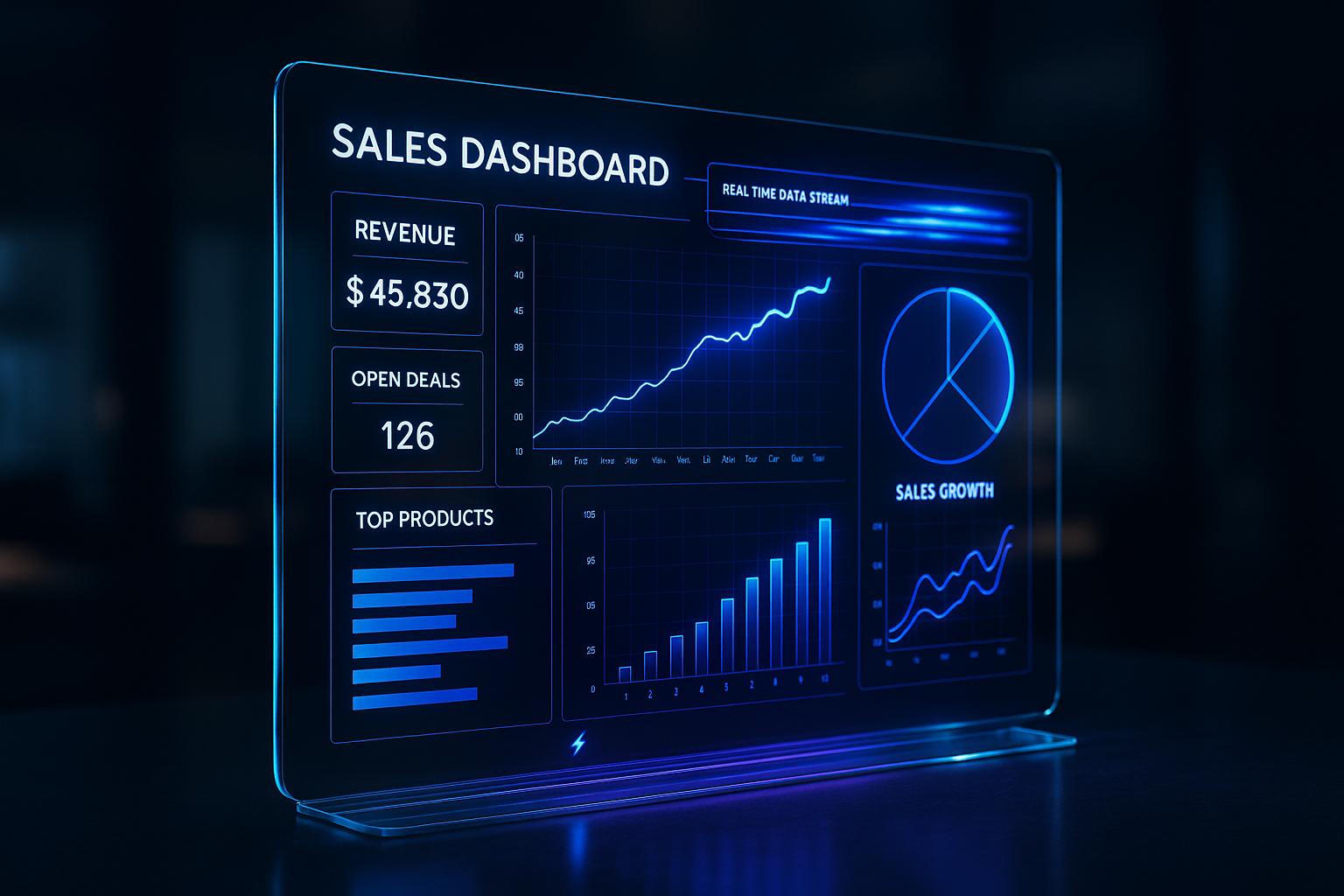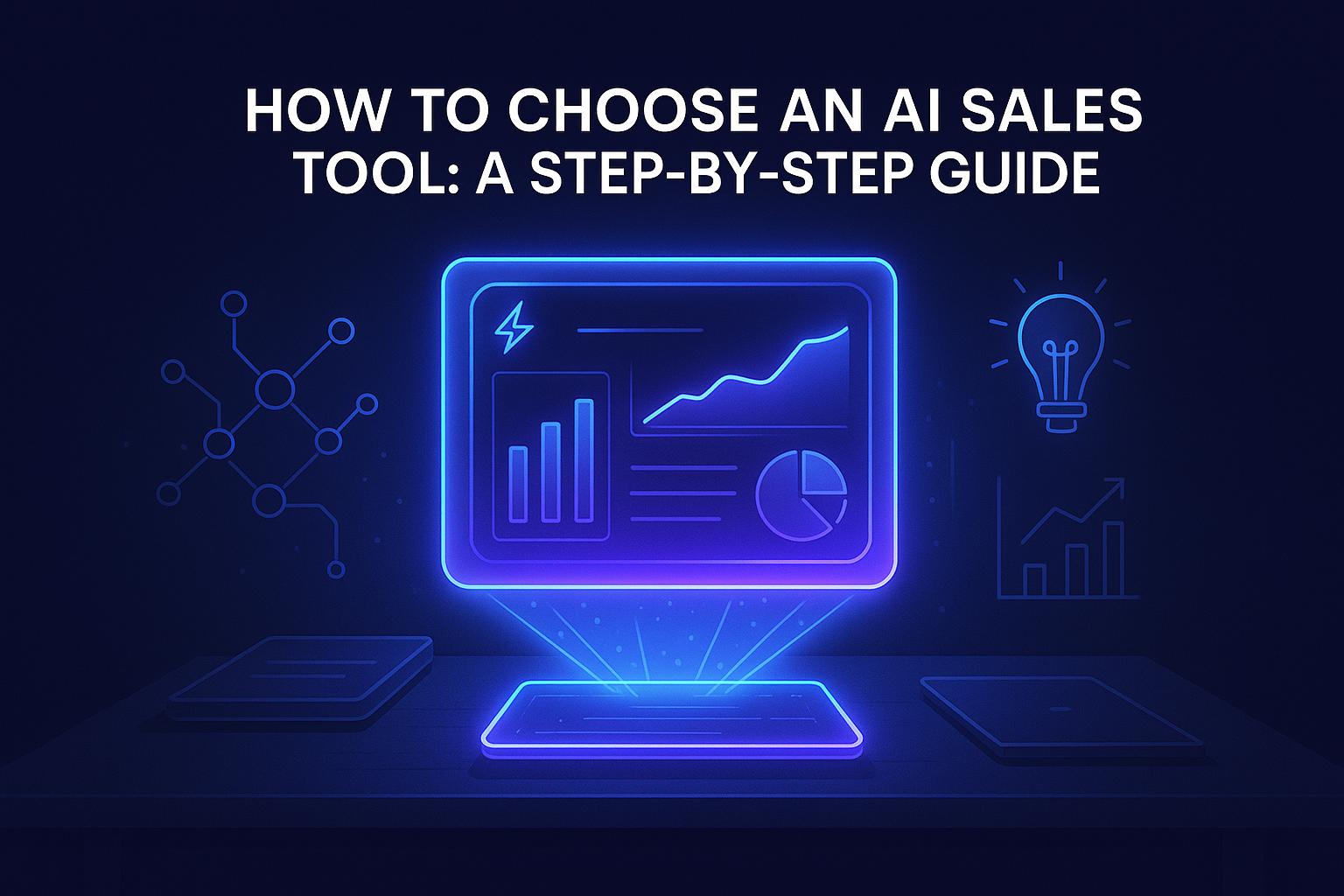AI sales tools can boost revenue by improving lead conversion, automating tasks, and enhancing team performance. Companies like Deel and Vanta have reported up to 20x revenue growth and 9x ROI using AI tools. Here's how these tools deliver results:
- Revenue Growth: Lead-to-meeting conversions can improve by up to 8x, and outbound productivity by 300%.
- Team Performance: Narrow the gap between top and average sellers by 60%.
- Cost Efficiency: Automate repetitive tasks and streamline workflows.
- Customer Experience: Deliver personalized interactions that increase satisfaction and retention.
To calculate ROI, use the formula: (Benefit – Cost) / Cost × 100. Factor in direct costs (like subscription fees) and hidden costs (like training and integration). Track metrics like sales growth, team productivity, and customer retention to measure impact effectively.
Quick Overview:
| Key Metric | AI Impact |
|---|---|
| Lead Conversion | Up to 8x increase |
| Outbound Productivity | 300% improvement |
| Performance Gap Reduction | 60% smaller gap |
| Customer Retention | 5.7x revenue impact |
AI tools like HubSpot Sales Hub, Salesforce Einstein, and Gong can transform sales processes. Success depends on integrating these tools with CRMs, providing team training, and tracking performance regularly.
How to Calculate AI Sales Tool ROI
Basic ROI Calculation Methods
The starting point for evaluating the return on investment (ROI) of AI sales tools is the classic formula: (Benefit – Cost) / Cost × 100. For instance, if you spend $15,000 on an AI sales tool and it generates $45,000 in additional sales, your ROI would be 200%. In this case, every dollar invested brings back $2.
But this straightforward calculation doesn’t always capture the full range of benefits AI sales tools can offer. A broader approach takes into account multiple areas of value:
| ROI Component | How It's Measured | Typical Impact Range |
|---|---|---|
| Direct Revenue | Additional sales generated | 20–300% increase |
| Productivity | Time saved × hourly cost | Up to 300% improvement |
| Lead Quality | Better conversion rates | Up to 8× higher |
| Team Performance | Narrowing the gap between top and average sellers | 60% reduction |
After calculating potential benefits, it’s essential to factor in all investment costs, both visible and hidden.
Investment and Setup Costs
A thorough ROI analysis requires understanding the complete cost of adopting an AI sales tool. This includes both direct expenses and less obvious costs:
| Cost Category | Direct Costs | Hidden Costs |
|---|---|---|
| Implementation | Subscription or licensing fees | Time spent researching |
| Integration | Technical setup fees | Adjusting internal processes |
| Training | Training program costs | Temporary drop in productivity |
| Infrastructure | Software or hardware upgrades | Data security measures |
| Maintenance | Ongoing support fees | Time spent monitoring systems |
Once you’ve mapped out the costs, the next step is to evaluate how these tools impact revenue and overall business performance.
Revenue Effects and Benefits
AI sales tools can drive revenue growth in several ways. For example, many users report receiving their first interested response from an AI-sequenced lead within just 24 hours. This speeds up the sales process and increases conversions.
Data also shows considerable improvements in areas like outbound productivity, lead conversion rates, and team alignment. These enhancements streamline the sales process and contribute to higher revenue.
To measure these benefits effectively, compare key metrics before and after implementing the AI tool. Focus on:
- Average deal size
- Sales cycle length
- Win rates
- Revenue per sales representative
- Customer lifetime value
Keep in mind that ROI evolves over time. Early results often highlight productivity gains, while long-term advantages may include improved customer retention and strategic growth opportunities.
Key Metrics for ROI Measurement
Sales Growth Numbers
Keep an eye on revenue metrics to evaluate how AI tools are affecting your bottom line. For example, some users have seen major improvements in lead prioritization, showing how AI strategies can enhance sales outcomes.
| Revenue Metric | Typical Impact | Measurement Method |
|---|---|---|
| Lead Conversion | Up to 8x increase | Compare lead-to-meeting booking ratios pre- and post-adoption |
Sales Team Performance
In addition to tracking lead conversion, take a closer look at how your sales team is performing overall. Many companies have reported a 60% smaller performance gap between their top and average sellers. AI tools help by automating repetitive tasks and providing actionable data insights.
| Performance Indicator | AI Tool Impact | Business Value |
|---|---|---|
| Response Time | First reply within 24 hours | Faster engagement with prospects |
| Rep Productivity | Up to 300% increase | Streamlined and more efficient sales process |
Customer Success Indicators
Finally, evaluate how AI tools are improving customer relationships and driving long-term outcomes. These tools can significantly enhance customer experience, satisfaction, and retention. Companies using AI for customer experience have reported generating 5.7 times more revenue.
| Success Metric | Impact Area | Measurement Focus |
|---|---|---|
| Customer Satisfaction | Experience Quality | Response time and resolution rate |
| Retention Rate | Long-term Value | Year-over-year customer retention |
| Upsell Success | Revenue Growth | Additional product adoption |
| Referral Rate | Brand Advocacy | New business acquired through referrals |
Steps to Increase ROI
CRM and Tool Connection
Linking AI tools with your CRM can significantly boost ROI. Recent integrations have shown measurable improvements.
"The AI sales process involves more than just implementing technology; it requires a strategic approach to embed AI seamlessly into every stage of the sales cycle."
A great example is HubSpot's AI Summarization tool. Introduced in 2024, it connects with CRM data to create clear summaries of customer interactions. These summaries offer actionable insights that enhance sales engagement.
| Integration Component | Impact | Implementation Focus |
|---|---|---|
| Data Synchronization | Real-time updates | Real-time field mapping |
| Workflow Automation | Time savings | Task automation triggers |
| Analytics Integration | Unified reporting | Combined metrics dashboard |
The next step is ensuring your team can effectively use these integrated insights.
Sales Team Training
Proper training is key to getting the most from AI tools. Top-performing teams mix advanced AI technology with tailored training programs.
For instance, Zoom's Chorus AI led to a 20% sales increase, while Diligent's Gong AI improved close rates by 7.4%.
"We use a video-analyzing AI that's revolutionized how we coach our sales team. This smart system dissects recorded sales calls, picking up on nuances that even seasoned managers might miss. The AI doesn't just offer generic tips; it provides tailored advice for each team member... Since implementing this 'AI coach,' our close rates have soared, and the team's confidence has skyrocketed." – Kacper Rafalski, Demand Generation Team Leader at Netguru
Once your team is trained and the tools are integrated, tracking performance is crucial to sustaining these gains.
Progress Tracking
Keep an eye on AI performance with both quantitative and qualitative metrics. Kronologic's AI, for example, increased engagement rates by automating meeting scheduling. By syncing with CRM systems, it personalizes outreach, leading to more responses and booked meetings.
| Tracking Metric | Target Range |
|---|---|
| Outbound Productivity | 300% increase |
| Performance Gap | 60% reduction |
| Customer Experience | 5.7x revenue impact |
To keep improving, regularly review these metrics and adjust your strategy as needed. This ensures you’re getting the most value while identifying areas for further refinement.
sbb-itb-3ed3a29
ROI for Your AI: Budgeting, Costing, and Measuring AI ...
Next Generation AI Sales Tools
Next-generation AI tools are reshaping sales processes by improving forecasting, communication, and automation, all while driving measurable ROI.
Sales Prediction Tools
AI-driven sales forecasting tools are changing the way businesses predict revenue and identify opportunities. By leveraging predictive analytics, these tools provide accurate demand forecasts, helping businesses allocate resources more effectively. For instance, HubSpot Sales Hub uses behavioral patterns, buying signals, and demographic data to predict which leads are most likely to convert. Beyond forecasting, AI is also making waves in customer engagement with advanced communication tools.
Customer Communication AI
AI-powered communication tools are taking personalization to a new level. Crystal's AI platform is a prime example, offering tailored messaging designed for each prospect. Similarly, Lavender's email optimization tool, starting at $27 per month, analyzes email content and recipient behavior to suggest improvements. This helps sales teams craft messages that connect with specific buyer personas and increase response rates. These tools go hand-in-hand with automation solutions that simplify workflows.
Sales Process Automation
AI is automating repetitive tasks while maintaining a personal touch. Fireflies.ai provides an AI meeting transcription service, capturing and analyzing sales conversations automatically.
SMARTe Copilot offers access to over 250 million contacts and 64 million companies, with 70% mobile coverage in North America.
For a more comprehensive solution, Salesforce Sales Cloud's Einstein 1 Sales platform delivers a full suite of AI-powered features. Priced at $500 per user per month, this platform integrates seamlessly with CRMs, streamlining sales processes and reducing manual work. These tools free up valuable selling time while optimizing efficiency and conversion rates, making them indispensable for modern sales teams.
Conclusion
AI sales tools can significantly boost revenue when implemented thoughtfully and tracked effectively. Success depends on selecting tools that fit your business needs - whether it's beginner-friendly options like HubSpot Sales Hub or more advanced platforms like Salesforce Einstein 1 Sales for deeper system integration.
Here are the key factors that drive success:
- Strategic Integration: Ensure AI tools work seamlessly with your CRM and sales workflows.
- Ongoing Training: Regularly train your team to get the most out of these tools.
- Performance Tracking: Monitor relevant metrics to evaluate impact and fine-tune your approach.
Choosing the right tools and following these strategies helps businesses create efficient, data-driven sales systems that consistently deliver strong results and measurable returns. This wraps up our discussion on maximizing ROI with AI sales tools.
FAQs
How do AI sales tools help increase lead conversion and boost outbound productivity?
AI sales tools improve lead conversion and outbound productivity by automating repetitive tasks, such as data entry and follow-up reminders, freeing up your sales team to focus on building relationships and closing deals. These tools also provide data-driven insights to help prioritize high-value leads, forecast sales more accurately, and make smarter decisions.
Additionally, AI-powered tools can create and refine sales content, tailoring messages to specific audiences for more personalized and effective outreach. By streamlining workflows and enhancing communication strategies, businesses can see a measurable improvement in both productivity and lead conversion rates.
What hidden costs should businesses consider when adopting AI sales tools, and how can they minimize them?
Hidden costs of adopting AI sales tools can include subscription fees, integration expenses, training for employees, and potential investments in additional software or hardware. Other factors, like the time spent on research and rollout, resistance to change from teams, and ensuring data privacy, can also add to the overall cost.
To minimize these costs, businesses should select tools that are user-friendly, require minimal training, and integrate seamlessly into existing workflows. Additionally, planning ahead for change management and prioritizing tools with clear ROI can help ensure a smoother and more cost-effective implementation.
How can businesses seamlessly integrate AI sales tools with their current CRM systems?
To successfully integrate AI sales tools with your existing CRM, start by mapping out your current sales processes. This helps identify areas where AI can have the most impact and ensures the integration aligns with your business goals.
Next, evaluate AI tools carefully by focusing on solutions that address your team’s biggest challenges or inefficiencies. Choose tools that complement your CRM and enhance its capabilities rather than complicating workflows.
Finally, prioritize ongoing optimization by monitoring performance metrics, collecting user feedback, and making adjustments as needed. Regular reviews will ensure the AI tools continue delivering measurable results and adapt to your evolving business needs.


